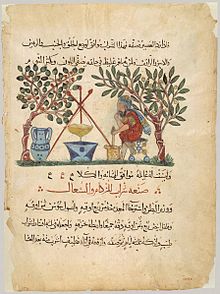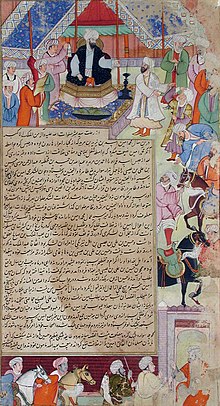Graeco-Arabic translation movement
[2] The ninth king of the Sasanian Empire, Shapur II, established the Academy of Gondishapur, which was to be a medical center, a library, as well as a college where various subjects like anatomy, theology, medicine, and philosophy would be studied.
[3] Later, Khosrow I established an observatory that could offer studies in dentistry, architecture, agriculture and irrigation, basics of commanding in military, astronomy, and mathematics.
These migrant scholars sought asylum in Persia, whose ruler actively ensured their safe passage out of Byzantium and supported their academic ambitions.
The Arab conquests before and during the Umayyad Period that spread into Southwest Asia, Persia, and Northeast Africa laid the groundwork for a civilization capable of fueling the Graeco-Arabic translation movement.
These conquests united a massive area under the Islamic State, connecting societies and peoples previously isolated, invigorating trade routes and agriculture, and improving material wealth among subjects.
In later periods, Muslim scholars built off of this infrastructure and gained the capacity to begin perform these translations themselves directly from the Greek originals and into Arabic.
[7] The Abbasid period encompassed one of the very critical markers in the movement's history, that is, the translation of the central texts of the Islamic religion, in this case, the Quran.
[10] One of Muhammad's contemporaries, an Arab doctor named Harith b. Kalada, is said to have studied in the medical academy at Gondeshapur, however this story is likely legendary.
There was an expansion of the Islamic empire, leading to searching of multilingual teachers as well as people to translate and teach the Quran and the Arabic language.
While Islam expanded, there was the preservation of other cultures by the Muslims and the utilization of technology and their knowledge of science in the efforts of stimulating their language to develop.
[13] These translators were also from many different cultural, religious, and ethnic backgrounds, including Persians, Christians, and Muslims, all working to develop a well-rounded inventory of educational literature in the House of Wisdom for the Abbasid Caliphate.
In 762 AD, Abu Jaʿfar Abdallah ibn Muhammad al-Mansur, the second Abbasid Caliph, decided to move the capital of the empire to his newly built city of Baghdad in Iraq from Damascus, which was in Syria.
[17] As a result, he established a library, the House of Wisdom, in Baghdad where scholars and students could study new material, formulate new ideas, transcribe literature of their own, and translate various works from around the world into the Arabic language.
Under the rule of Abu al-Abbas Abdallah ibn Harun al-Rashid (better known as al-Maʿmun) the House of Wisdom thrived, acquiring a large amount of support and recognition.
[19] Due to the translation movement under al-Maʿmun, the House of Wisdom was one of the largest repositories of scientific and literary books in the world at the time and remained that way until the Siege of Baghdad in 1258 AD.
[20] Abu Zaid Hunayn ibn Ishaq al-Ibadi was a profound Arab physician, philosopher, author and leading translator in the House of Wisdom .
Hunayn's knowledge of Persian, Syriac, and Arabic exceeded that of previous prevalent translators, which enabled him to revise their erroneous renditions.
Galen, Hippocrates, Plato, Aristotle, Dioscorides, and Ptolemy were just a few of many writers that Hunayn used for his translated publications of medical and philosophical expositions.
[21] Hunayn was a highly intelligent person who paid very close attention to detail and found many mistakes in his assigned medical textbooks, so would often ask difficult questions no one at his school had the answer to.
Hunayn, his son Ishaq, his nephew Hubaysh, and fellow colleague Isa ibn Uahya became very involved in translating medicinal and science texts.
This led to the beginning of Hunayn's success into the translation movement, where he interpreted the works of famous Greek and Arabic figures: Plato, Aristotle, Hippocrates, Galen, and Dioscorides.
Hunayn had a specific way of absorbing information by attempting to attain the meaning of the subject prior to rewriting it, which was very rare to witness during his time.
[8] However, Ishaq was more interested in philosophy and would go on to translate several famous philosophical writings such as That the Prime Mover is Immobile and pieces of Galen's On Demonstration.
Ninth century Arab Muslim philosopher al-Kindi, for example, viewed Greek texts as a resource in which he was able to employ new ideas and methods off of, thus, re-inventing philosophy.





